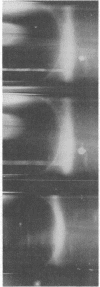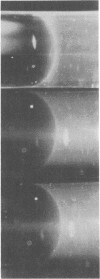Abstract
A micro capillary agar-gel diffusion system for the detection of botulinal toxin in foods and cultures was developed and evaluated. Toxins types A, B, and E, produced in culture broth with and without added trypsin, and type E toxin, produced in inoculated canned clams, were tested with this system and with the mouse bioassay procedure. With nontrypsinized toxin, the capillary diffusion system detected as little as 100 minimal lethal doses (MLD) per ml but was effective only at higher levels, 106 to 1.5 × 107 MLD/ml, when used with trypsinized toxin. The inability to detect lower levels of trypsinized toxin was due to thioglycolate present in the medium used to produce toxin. Evidently, trypsinization of toxin produces polypeptides still held together by disulfide bonds. Cleavage of these bonds by reduction with thioglycolate reduces the sensitivity of the capillary method. Trypsinized toxin produced in broth without thioglycolate was detected as readily as nontrypsinized toxin. Toxin was detected in canned clams containing as low as 100 MLD/ml. No cross-reactions were observed with type E toxin and types A and B antitoxins. Extensive studies using the capillary method for detecting types A and B toxins were not performed; however, a suspected sample of commercially canned mushrooms gave a positive type B reaction but not a type A reaction. This typing was confirmed later by the mouse bioassay. Toxin was present at a level of 100 MLD/ml. The procedure developed may prove useful as a rapid screening method for the detection of botulinal toxin in foods, with final identification made by using the mouse bioassay.
Full text
PDF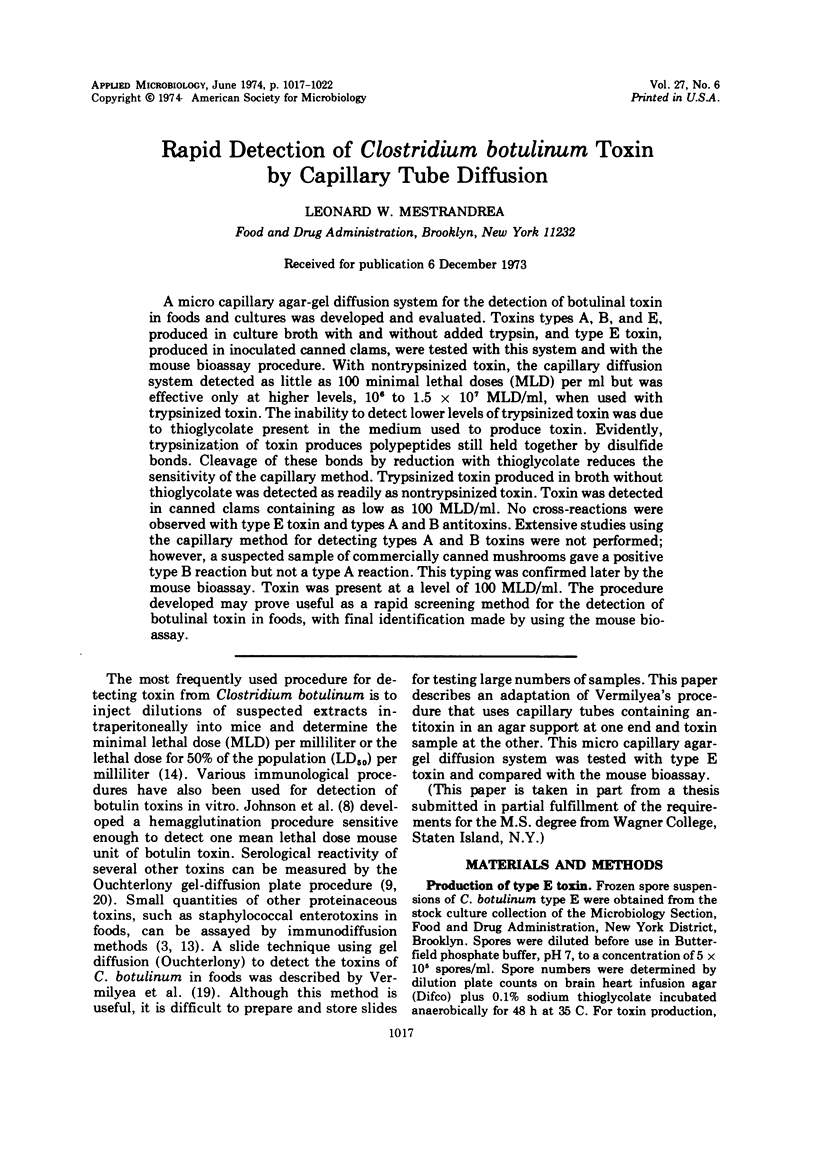
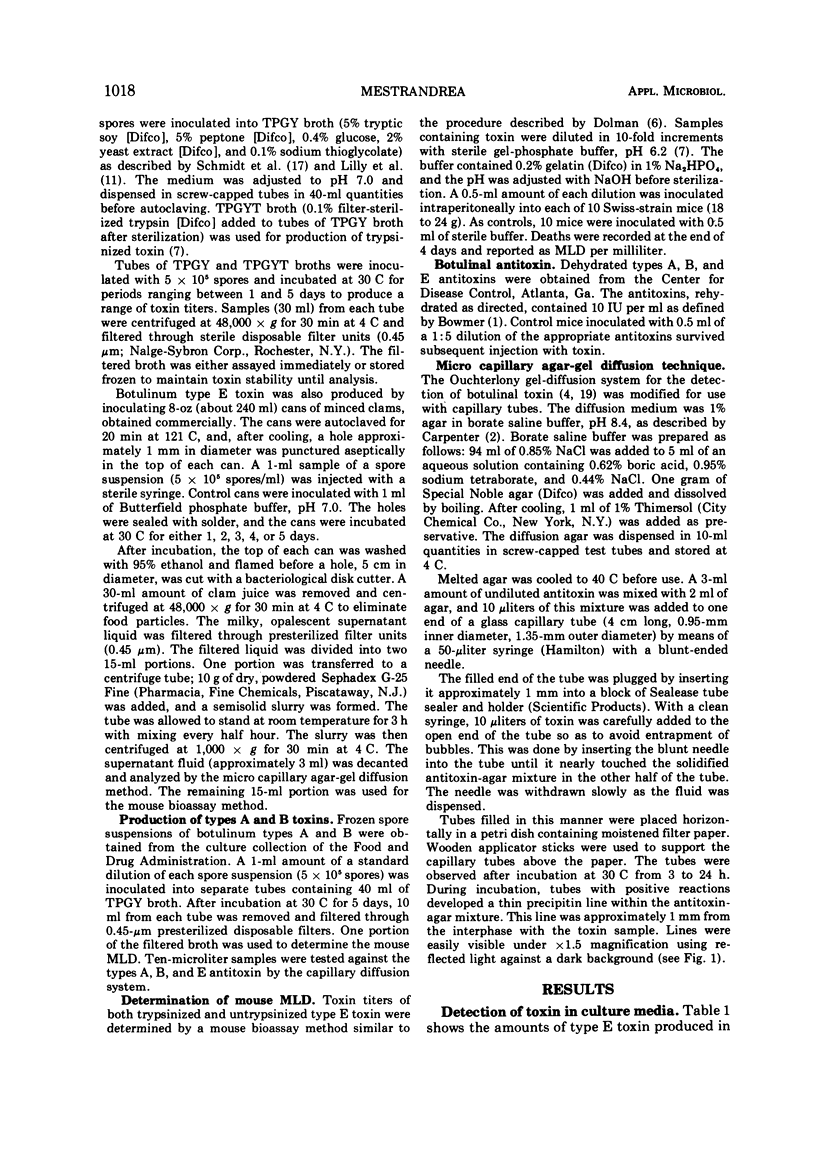
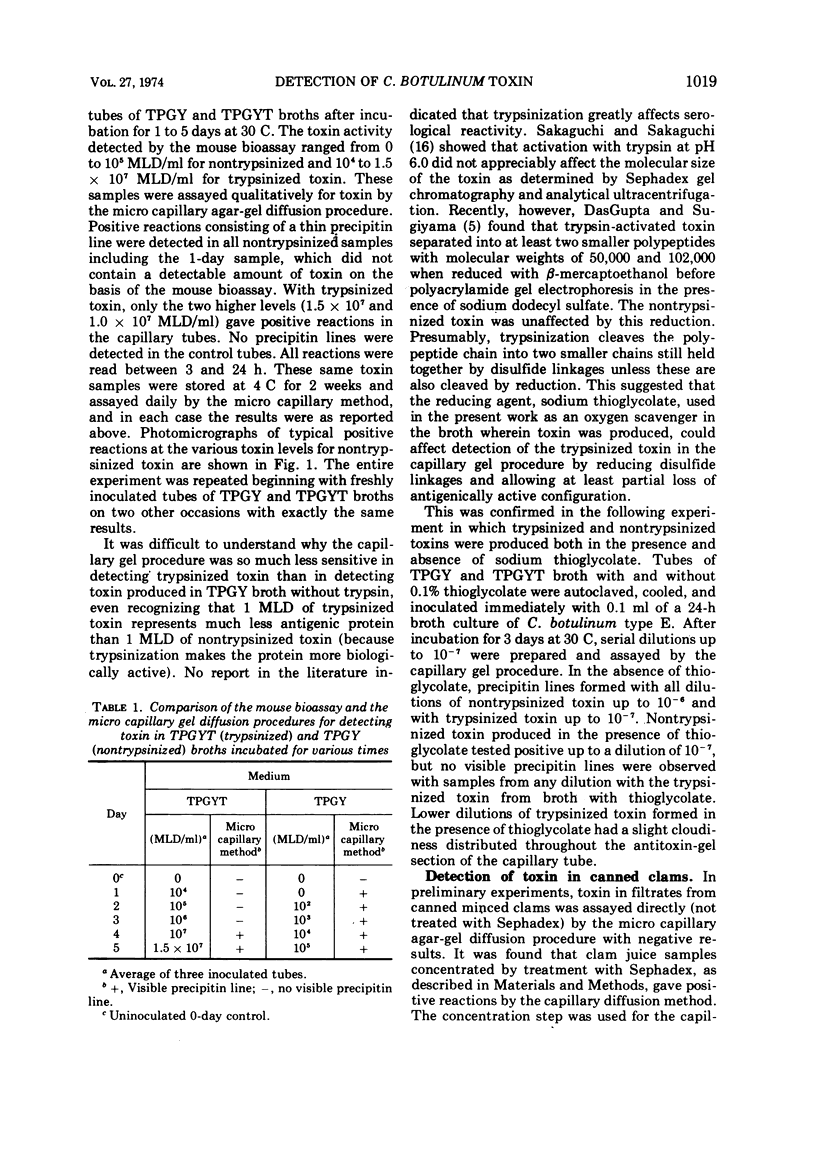
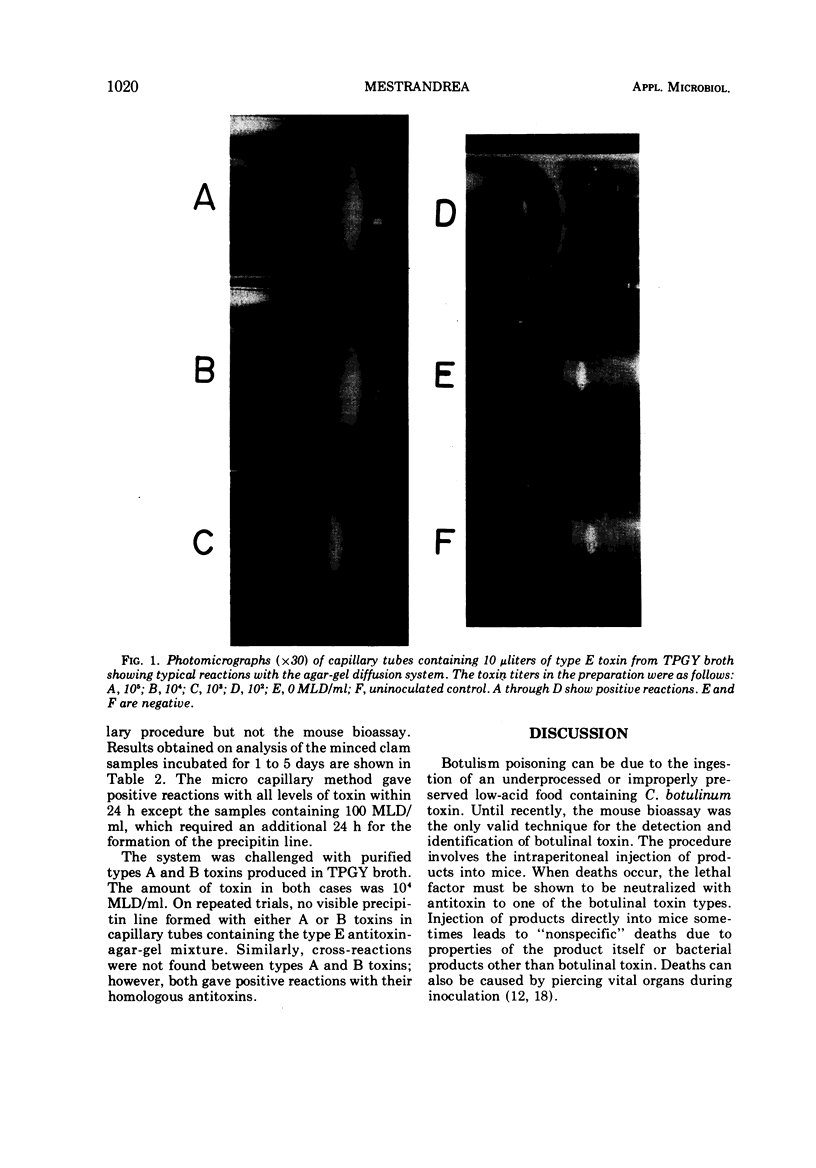
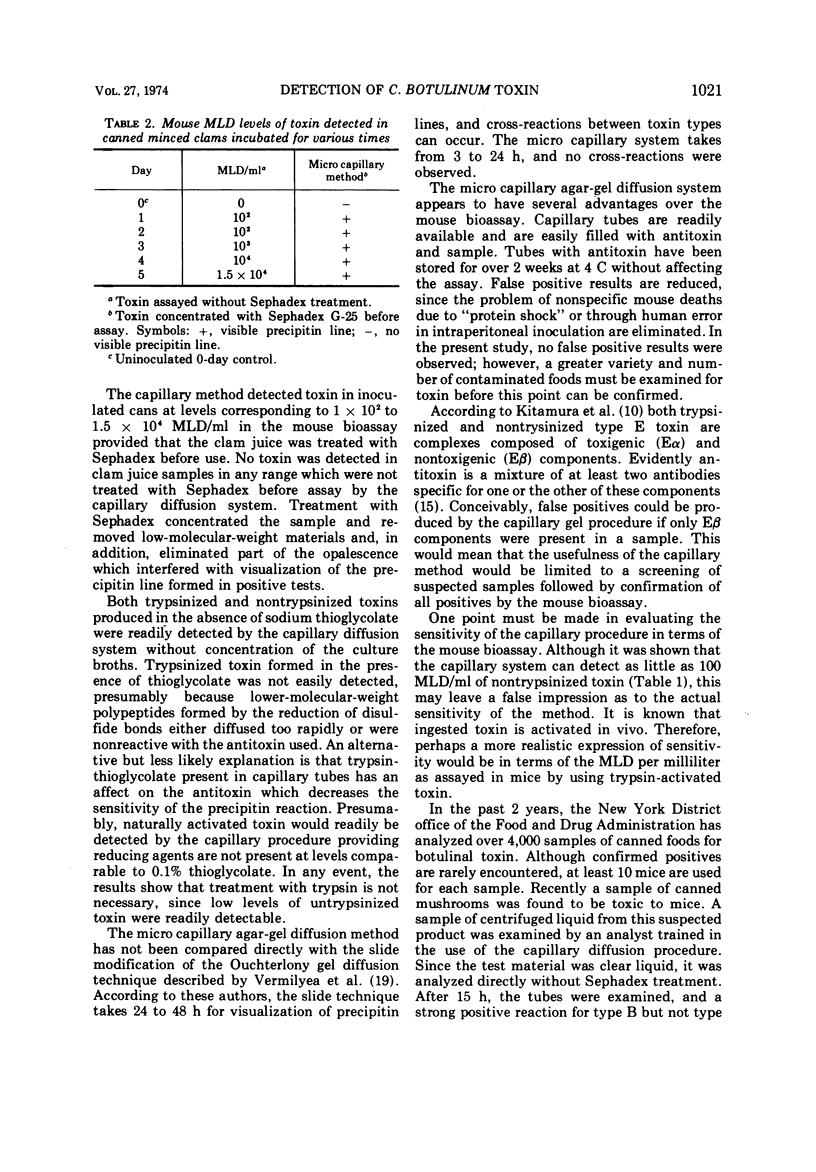

Images in this article
Selected References
These references are in PubMed. This may not be the complete list of references from this article.
- BOWMER E. J. PREPARATION AND ASSAY OF THE INTERNATIONAL STANDARDS FOR CLOSTRIDIUM BOTULINUM TYPES A, B, C, D AND E ANTITOXINS. Bull World Health Organ. 1963;29:701–709. [PMC free article] [PubMed] [Google Scholar]
- CASMAN E. P., BENNETT R. W. DETECTION OF STAPHYLOCOCCAL ENTEROTOXIN IN FOOD. Appl Microbiol. 1965 Mar;13:181–189. doi: 10.1128/am.13.2.181-189.1965. [DOI] [PMC free article] [PubMed] [Google Scholar]
- CROWLE A. J. A simplified micro double-diffusion agar precipitin technique. J Lab Clin Med. 1958 Nov;52(5):784–787. [PubMed] [Google Scholar]
- DUFF J. T., WRIGHT G. G., YARINSKY A. Activation of Clostridium botulinum type E toxin by trypsin. J Bacteriol. 1956 Oct;72(4):455–460. doi: 10.1128/jb.72.4.455-460.1956. [DOI] [PMC free article] [PubMed] [Google Scholar]
- DasGupta B. R., Sugiyama H. A common subunit structure in Clostridium botulinum type A, B and E toxins. Biochem Biophys Res Commun. 1972 Jul 11;48(1):108–112. doi: 10.1016/0006-291x(72)90350-6. [DOI] [PubMed] [Google Scholar]
- Johnson H. M., Brenner K., Angelotti R., Hall H. E. Serological studies of types A, B, and E botulinal toxins by passive hemagglutination and bentonite flocculation. J Bacteriol. 1966 Mar;91(3):967–974. doi: 10.1128/jb.91.3.967-974.1966. [DOI] [PMC free article] [PubMed] [Google Scholar]
- Kitamura M., Sakaguchi S., Sakaguchi G. Purification and some properties of Clostridium botulinum type-E toxin. Biochim Biophys Acta. 1968 Oct 21;168(2):207–217. doi: 10.1016/0005-2795(68)90144-x. [DOI] [PubMed] [Google Scholar]
- Miner N. A., Koehler J., Greenaway L. Intraperitoneal injection of mice. Appl Microbiol. 1969 Feb;17(2):250–251. doi: 10.1128/am.17.2.250-251.1969. [DOI] [PMC free article] [PubMed] [Google Scholar]
- READ R. B., Jr, BRADSHAW J., PRITCHARD W. L., BLACK L. A. ASSAY OF STAPHYLOCOCCAL ENTEROTOXIN FROM CHEESE. J Dairy Sci. 1965 Apr;48:420–424. doi: 10.3168/jds.s0022-0302(65)88246-7. [DOI] [PubMed] [Google Scholar]
- Steward J. P., Ornellas E. P., Beernink K. D., Northway W. H. Errors in the technique of intraperitoneal injection of mice. Appl Microbiol. 1968 Sep;16(9):1418–1419. doi: 10.1128/am.16.9.1418-1419.1968. [DOI] [PMC free article] [PubMed] [Google Scholar]
- Vermilyea B. L., Walker H. W., Ayres J. C. Detection of botulinal toxins by immunodiffusion. Appl Microbiol. 1968 Jan;16(1):21–24. doi: 10.1128/am.16.1.21-24.1968. [DOI] [PMC free article] [PubMed] [Google Scholar]
- WADSWORTH C. A slide microtechnique for the analysis of immune precipitates in gel. Int Arch Allergy Appl Immunol. 1957;10(6):355–360. doi: 10.1159/000228394. [DOI] [PubMed] [Google Scholar]



